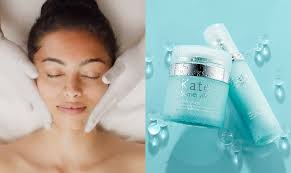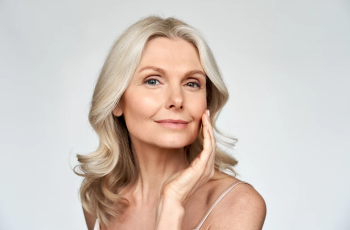
Aquaporins in Skincare and Injectable Fillers: What You Need to Know
As a dermatologist and skincare expert, I often get questions about cutting-edge skincare ingredients like aquaporins.
These proteins have recently caught attention because their activity seems to rise when SkinVive, a hyaluronic acid injectable, is used.
But what exactly are aquaporins? And can they really hydrate your skin when added to creams? Let’s dive deep into the science and skincare relevance of aquaporins.
What Are Aquaporins?
Aquaporins (AQPs) are special proteins embedded in cell membranes that act like tiny water channels. They allow water and certain small molecules to pass through cell barriers quickly.
In mammals, there are 13 known types of aquaporins. Some transport only water, while others also move glycerol and small solutes.
For example, AQP3 transports water and glycerol, important for skin hydration.
These channels help maintain water balance between cells, a crucial process for healthy skin. Aquaporins are integral to how our skin stays moist, heals wounds, and protects itself.
They are not just random proteins but active facilitators of skin hydration and function.
Why Don’t You See Aquaporins on Skincare Labels?
You might wonder why you never see “aquaporin” listed in ingredient lists. The truth is, aquaporins themselves are large proteins that can’t easily penetrate the skin barrier when applied topically.
So, creams containing aquaporins won’t directly boost your skin’s aquaporin levels.
Instead, the key is to find ingredients that stimulate your skin’s own aquaporins.
These compounds help increase the expression and activity of aquaporin channels in your skin cells, enhancing water and glycerol transport naturally.
How Do Skincare Ingredients Activate Aquaporins?
Aquaporins do not need energy to move water; they work by passive diffusion.
However, their presence and activity on cell membranes can be increased by other cellular signals, such as growth factors or cytokines.
These signals cause more aquaporin proteins to be produced and inserted into membranes.
When more channels are available, water and small molecules flow more freely, leading to better hydration.
In skincare, some ingredients trigger these biological pathways to boost aquaporin levels, improving skin moisture and barrier health.
Ingredients Known to Stimulate Aquaporins
Ajuga Turkestanica
One of the most studied natural aquaporin stimulators is Ajuga turkestanica, a herb used traditionally and in bodybuilding supplements. It contains bioactive compounds like phytoecdysteroids.
Studies show that extracts of Ajuga turkestanica increase the expression and activity of AQP3 in skin cells. In lab cultures, it raises AQP3 protein levels.
Applied topically on volunteers, it boosted AQP3 gene activity and reduced transepidermal water loss (TEWL).
This means Ajuga turkestanica can enhance the skin’s natural moisturizing channels, improving hydration and barrier function.
While aquaporins themselves cannot enter the skin, this herb modulates the pathways that control them. It’s a promising botanical ingredient for hydration.
Cannabinoids (CBD)
Cannabidiol (CBD), derived from cannabis, is gaining popularity for skincare.
Recent research shows CBD can selectively increase AQP3 expression in epidermal keratinocytes—the cells forming the skin’s outer layer.
In a mouse study, daily topical 1% CBD application significantly boosted skin hydration. This effect was linked directly to higher AQP3 levels at both the gene and protein stages.
Interestingly, CBD did not change other moisturizers like ceramides or hyaluronic acid, highlighting its specific effect on aquaporins.
CBD might work through activating PPARγ receptors, a type of nuclear receptor involved in skin health.
This makes CBD a promising cosmetic ingredient for improving hydration by enhancing aquaporin activity.
Some face oils combine cannabis seed oil with jojoba, moringa, and rosehip oils to both hydrate and stimulate aquaporin channels.
Glyceryl Glucoside
Glyceryl glucoside is a natural humectant that can boost AQP3 activity. Research on human keratinocytes shows that it increases AQP3 mRNA and protein.
When applied topically, glyceryl glucoside penetrates the epidermis and upregulates AQP3 gene expression.
This stimulation helps reduce water loss and improves the skin’s barrier function.
Products with glyceryl glucoside include Eucerin Aquaporin Active and Zerafite Wrinkle Defense Barrier Cream, both formulated to repair the skin barrier and enhance moisture retention.
Retinoic Acid
Retinoic acid, a vitamin A derivative, is famous for treating acne and aging skin.
However, it often causes dryness and irritation. Interestingly, studies on human keratinocytes show retinoids can increase AQP3 levels and cell proliferation.
This might explain why retinoids dry out the skin—they increase aquaporin activity, which can paradoxically enhance water loss if the skin barrier is compromised.
Understanding this relationship could help optimize retinoid use to balance hydration and treatment benefits.
Turmeric (Curcumin)
Turmeric contains curcumin, an active compound shown to boost AQP3 expression in skin cells. It may act by activating PPARγ receptors, similar to CBD.
Topical turmeric extracts have raised AQP3 levels in animal studies, contributing to skin hydration.
Many skincare products now incorporate turmeric for its antioxidant, anti-inflammatory, and aquaporin-stimulating properties.
Aquaporins and Dermal Fillers
Injectable fillers like SkinVive, Restylane, and Juvederm contain hyaluronic acid, a molecule with excellent water-binding ability.
When injected, these fillers absorb water from surrounding tissues, expanding and hydrating the skin mechanically.
This expansion might stimulate aquaporins, increasing water transport into skin cells.
While this is a promising hypothesis, more research is needed to fully understand the exact mechanisms behind injectable fillers and aquaporin activation.
Different Types of Aquaporins in Skin
Aquaporin 3 (AQP3)
AQP3 is the most abundant aquaporin in human epidermis. It transports water and glycerol—key for skin hydration.
Studies show mice lacking AQP3 suffer dry, less elastic skin with impaired barrier repair.
Aquaporin 5 (AQP5)
AQP5 is primarily found in sweat glands, helping regulate sweat secretion. Research shows it may also influence skin cell proliferation.
Reduced AQP5 expression appears in some inflammatory skin diseases, possibly worsening symptoms.
Aquaporin 9 (AQP9)
AQP9 is localized in the upper layers of the epidermis, transporting glycerol and urea. It contributes to skin moisture balance but is less well-studied than AQP3 or AQP5.
How Aquaporins Hydrate Skin
Aquaporins enable the transport of water, glycerol, and small solutes between skin cells. Glycerol acts as a natural moisturizing factor, while water keeps cells hydrated.
By shuttling these molecules, aquaporins support skin cell growth, differentiation, and wound healing. They are dynamic channels crucial for skin hydration and barrier maintenance.
Why Topical Aquaporins Don’t Work
Aquaporins are large membrane proteins that cannot penetrate skin when applied in creams. So, products claiming to contain aquaporins likely have no direct effect.
Instead, the best approach is to use ingredients that stimulate your skin’s natural aquaporin production. These include certain botanicals, cannabinoids, glyceryl glucoside, retinoids, and antioxidants.
Injectables like SkinVive may also activate aquaporins from within, enhancing hydration in a way topical products cannot.
Aquaporins and Skin Barrier Function
The skin barrier protects against water loss and irritants. When damaged, as in eczema or dry skin, aquaporin activity changes. For example:
AQP3 expression increases, which may cause excessive water loss.
AQP5 levels decrease in inflammatory skin diseases, disrupting water balance.
Though still under study, aquaporins play a vital role in skin barrier health and moisture regulation.
Aquaporins in Skin Inflammation and Conditions
Rosacea
Research reveals AQP3 is upregulated in rosacea, a chronic inflammatory skin condition. In mice, deleting AQP3 reduced rosacea symptoms by dampening immune responses.
AQP3 helps activate NF-κB, a key inflammation pathway, and supports immune cell recruitment. It also influences T helper 17 cells involved in autoimmune inflammation.
This suggests AQP3 could be a future therapeutic target for rosacea.
Acne
Acne-affected skin shows higher AQP3 levels than normal skin. This increased water transport may affect sebum production and inflammation, contributing to acne’s pathology.
More research is needed, but modulating aquaporins might become part of acne treatment strategies.
Summary: The Role of Aquaporins in Skincare
Aquaporins are essential channels that help skin cells stay hydrated and healthy by moving water and glycerol.
Directly adding aquaporins to skin doesn’t work, but stimulating your skin’s own aquaporins can boost hydration and barrier repair.
Ingredients like Ajuga turkestanica, cannabinoids, glyceryl glucoside, retinoids, and turmeric show promise in activating aquaporins.
Injectable fillers with hyaluronic acid may also enhance aquaporin activity from within the skin.
Understanding and targeting aquaporins offers exciting new ways to improve skin hydration, barrier function, and treat inflammatory conditions like rosacea and acne.
For personalized skincare tailored to your unique skin type, take a detailed skin quiz. It can help you choose products that support your skin’s natural aquaporin channels and overall health.


